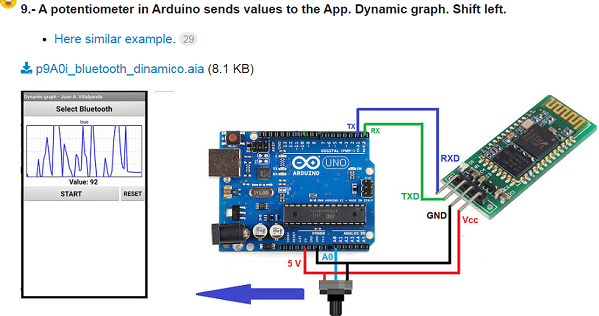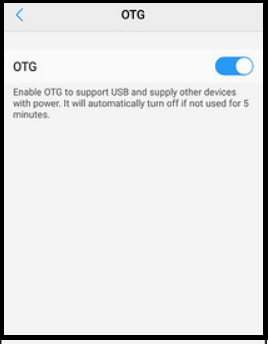That is the third request for the same thing.
Please do not spam the forum like this.
https://community.appinventor.mit.edu/t/serial-usb-connection/3162/28
https://community.appinventor.mit.edu/t/using-serial-with-ftdi/14136/76
That is the third request for the same thing.
Please do not spam the forum like this.
https://community.appinventor.mit.edu/t/serial-usb-connection/3162/28
https://community.appinventor.mit.edu/t/using-serial-with-ftdi/14136/76
Im sorry sir
6.- A potentiometer in Arduino sends values to the App. Dynamic graph. Shift left.
p10A_OTG_potenciometro.aia (198.8 KB)
In this topic we saw how to send information via Bluetooth and display it in a dynamic graph:

Now we are going to carry out the same practice but sending the data by a module UART:
I will use CP2102 and an OTG cable.
The version of the SerialOTG extension used is: Data Built: 2021-02-03
- Arduino code:
// Juan A. Villalpando
// http://kio4.com/appinventor/10A_OTG_LCD.htm
#include <SoftwareSerial.h>
#include <Wire.h>
SoftwareSerial UART(10, 11) ; // UART(TX,RX)
int value_pot0;
void setup() {
Serial.begin(9600);
UART.begin(9600);
Wire.begin();
}
void loop() {
value_pot0 = analogRead(A0);
Serial.println(value_pot0);
UART.println(value_pot0);
delay(100); // Debe ser más lento que el Reloj.
}
Why don't you just answer the request. Where is the .aix file ?
Get com.SerialOTG.aix:
7.- Testing version 2022-10-19.
p10A_OTG_Add.aia (190.4 KB)
https://github.com/rkl099/Appinventor_Debug

Settings / Additional settings / OTG / Enable OTG.

Android 9. MIT Companion and installed.
String a;
String b;
int c;
int d;
void setup() {
Serial.begin(9600);
}
void loop() {
if(Serial.available()) {
a = Serial.readStringUntil(',');
b = Serial.readStringUntil('\n');
c = a.toInt() + b.toInt();
d = a.toInt() * b.toInt();
Serial.print(c);
Serial.print(",");
Serial.println(d);
}
}


That example uses Date Built 2020-11-21
com.SerialOTG_201121.aix (185.4 KB)
For more security, contact the author of the extension @rkl099
thank you !
What is not working?
actually , I want to replace the bluetooth conexion with OTG..
I'm searching how to replace the blocs.
Ok, you are using an old version with the suffix “serial” in the names. This has been removed since it’s redundant, and only makes the names longer. See the documentation for the extension.
With this extension, it should be possible to use serial, BT or TCP/IP in the same way, except for timing.
I checked the extension for the ability to send ANSI characters (А,Б,В,Г,Д,Е,Ж,З,И,Й,К,Л,М,Н,О,П,Р,С,Т,У,Ф,Х,Ц,Ч,Ш,Щ,Ъ,Ы,Ь,Э,Ю,Я,а,б,в,г,д,е,ж,з,и,й,к,л,м,н,о,п,р,с,т,у,ф,х,ц,ч,ш,щ,ъ,ы,ь,э,ю,я)
This extension couldn't help me.
Are there any other extensions that can send and receive ANSI characters?
Tell us what you want to receive by sending these characters and what you are getting now.
I need to manage a JDY-41 module.
JDY-41 transmits and receives ANSI table characters,
from "\0" to "я"
For example, the standard extension ai2 "BluetoothClient" ,
supports transmission of all ANSI characters (255 pcs.).
Standard component ai2. "Serial" (as well as "SerialOTG" views here),
only half of the ANSI character table (127 pieces) is transmitted.
I need the transmission to be characters (like "µ,¶, ,ё,№,є,",ј,S,ѕ,ї,А,Б,В....."),
the JDY-41 module then responds to the commands.
Here is a picture from my terminal
as you can see byte exchange
happens not .hex numbers, but characters from "\0" to "я"
Here I want to ask the experts
is it possible
expand the range of transmitted characters for "SerialOTG"?
Appinventor uses UTF8 encoding for strings/characters. It’s not compatible with ANSI.
ANSI encoding is normally associated with Microsoft and uses code pages to define characters with hex codes 0x80 – 0xff. Characters 0X00 – 0x7f are the same for ASCII, ANSI, UTF8 and can be used without problems in Appinventor to communicate with Arduino etc.
If you need access to characters 0x80 – 0xff you have to use bytes, that allows you to send/receive all 256 values. That was one reason for implementing SerialOTG.
Appinventor can work well with ANSI encoding as well.
Here is an example of how I set the encoding,
for the standard "BluetoothClient" component.
OK, this is a property of the built in component for bluetooth communication.
SerialOTG already is a complex software that can handle many USB/serial adapters, communication as byte streams for bluetooth client/server, tcp/ip client/server, serial, as well as arduino programming. It’s to much work to expand it with ANSI characters with code page selection, signed/unsigned 1/2/4 byte numbers, byte order and more features that has been asked for.
So for now, you have to translate to/from bytes if you want to use SerialOTG.
Thanks for your work.
I already made an ANSI worksheet, for Java
static final String[] digitsHex1 = new String[]{"\u0000","\u0001","\u0002","\u0003","\u0004","\u0005","\u0006","\u0007","\b","\t","\n","\u000B","\f","\r","\u000E","\u000F","\u0010","\u0011"
,"\u0012","\u0013","\u0014","\u0015","\u0016","\u0017","\u0018","\u0019","\u001A","\u001B","\u001C","\u001D","\u001E","\u001F"," ","!","\"","#","$","%","&","'","(",")","*","+"
,",","-",".","/","0","1","2","3","4","5","6","7","8","9",":",";","<","=",">","?","@","A","B","C","D","E","F","G","H","I","J","K","L","M","N","O","P","Q","R","S","T","U","V","W"
,"X","Y","Z","[","\\","]","^","_","`","a","b","c","d","e","f", "g","h","i","j","k","l","m","n","o","p","q","r","s","t","u","v","w","x","y","z","{","|","}","~","\u007F"
,"Ђ","Ѓ","‚","ѓ","„","…","†","‡","€","‰","Љ","‹","Њ","Ќ","Ћ","Џ","ђ","‘","’","“","”","•","–","—","\u0098","™","љ","›","њ","ќ","ћ","џ"," ","Ў","ў","Ј","¤","Ґ","¦","§","Ё","©"
,"Є","«","¬","","®","Ї","°","±","І","і","ґ","µ","¶","·","ё","№","є","»","ј","Ѕ","ѕ","ї","А","Б","В","Г","Д","Е","Ж","З","И","Й","К","Л","М","Н","О","П","Р","С","Т","У"
,"Ф","Х","Ц","Ч","Ш","Щ","Ъ","Ы","Ь","Э","Ю","Я","а","б","в","г","д","е","ж","з","и","й","к","л","м","н","о","п","р","с","т","у","ф","х","ц","ч","ш","щ","ъ","ы","ь","э","ю","я"};
perhaps this will help somehow.
(I'm sorry in advance if i read your post wrong, because i am writing and reading a message through Google Translate)
Hope that will solve your problem. Good luck.